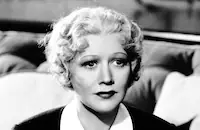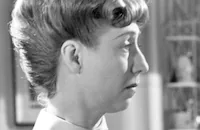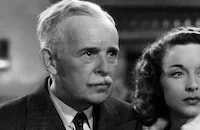Love Is a Headache

Brief Synopsis
Cast & Crew
Richard Thorpe
Gladys George
Franchot Tone
Ted Healy
Mickey Rooney
Frank Jenks
Film Details
Technical Specs

Synopsis
Carlotta "Charlie" Lee, a Broadway star whose latest play, A Lady of Experience is a big flop, is constantly criticized in the newspaper and on radio by "Broadway Chatter" columnist Peter Lawrence. Pete, who grew up with Charlie and has been in love with the independent actress for years, hopes that negative reaction to his columns will actually help her career. One day, when Pete learns about the untimely death of window washer O'Toole, he broadcasts a plea to his listeners to help O'Toole's orphaned son "Mike" and daughter "Jake." Hearing the broadcast, Charlie's publicity agent, Jimmy Slattery, thinks that if Charlie adopted the orphans she would get some great publicity, so he secretly arranges for the kids to be sent to her apartment. When Charlie comes home, she is furious with Jimmy, especially because the uncultured Mike and Jake have wrecked her elegant bedroom, but she soon decides that she likes them after all and wants to keep them. When Pete finds out that Charlie has the children, he confronts her and accuses her of trying to use them, but she convinces him that she is "on the level," and promises that there will be no publicity about the children. Some time later, despite her promise, Jimmy gets a picture of Charlie and the children in the newspaper, after which Pete threatens to take them to the child welfare bureau. To prevent this from happening, Charlie agrees to marry Reggie Odell, a millionaire who is in love with her and very fond of Jake and Mike. Jimmy, meanwhile, arranges for a fake kidnapping of the children to gain more publicity. When the police discover what has happened, they want to bring charges against Charlie, and Reggie tries to straighten things out with the police commissioner, but he resolves to get the children away from her. By now very attached to Jake and Mike, Charlie decides to take them out of New York and hide them in a small town hotel. Pete discovers where they are and follows her, hoping to prevent her being arrested. At the hotel, which is run by Janet Winfield, the local justice of the peace, Charlie and Pete discuss what to do about the children. While Janet eavesdrops outside the door, Charlie tells Pete that he has to marry her for the sake of the children. Janet then bursts into the room with a shotgun and marries them while she keeps a shotgun pointed at Pete. Because Charlie and Pete have been in love for years, neither minds the shotgun wedding and they look forward to a happy family life with Mike and Jake.

Director

Richard Thorpe
Cast

Gladys George

Franchot Tone

Ted Healy

Mickey Rooney
Frank Jenks

Ralph Morgan

Virginia Weidler

Jessie Ralph

Fay Holden
Barnett Parker
Julius Tannen

Henry Kolker
Sarah Edwards
Oscar O'shea
Leyland Hodgson
Jules Cowles
Sidney Bracy
Chester Clute

Phillip Terry
Jack Norton
Sam Ash
June Brewster
Chester Gann
Lillian Read
Buster Slaven
George Billings
Leonard Kibrick
Hal Leseur
Ralph Bushman
Leigh De Lacy
Cyril Ring
Gil Patrick
Don Brodie
Ernie Alexander
Robert Middlemass
Edgar Dearing

Marie Blake

Howard Hickman
James Farley
Richard Cramer
Bea Nigro
Crew
Adrian
Tom Andre
Cedric Gibbons
Lou Heifetz
Herbert Klein
William R. Lipman
Conrad A. Nervig
Marion Parsonnet
Harry Ruskin
John Seitz
Douglas Shearer
Frederick Stephani
Edward Ward
Edwin B. Willis
Joseph Wright

Film Details
Technical Specs

Articles
Love is a Headache
Rooney is fourth-billed in Love Is a Headache, showing his growing importance to the studio. It's a screwball comedy about Broadway star Carlotta Lee (Gladys George) who is pushed by her press agent (Ted Healy) into adopting an orphaned brother and sister, played by Rooney and Virginia Weidler, for publicity reasons. Franchot Tone plays a Broadway columnist who's in love with Carlotta, but worries about the kids.
Gladys George, a theater actress who had been signed by MGM in 1934, had been playing heavy dramatic roles in tearjerkers such as Valiant Is the Word for Carrie (1936), which earned her a Best Actress Oscar® nomination, and the title role in Madame X (1937). The role of the glamorous Broadway star in Love Is a Headache gave George a rare chance to cut loose with comedy, and she's terrific, her husky voice swooping from the dulcet tones of the grande dame she's turned herself into, to the guttersnipe gravel of the character's origins. Her screwball love-hate banter with Franchot Tone, as comfortable in comedy as he was in drama, is witty and effective.
Ted Healy, who played George's press agent, was a former vaudevillian who created an act called "Ted Healy and his Stooges" with his childhood friends, brothers Moe and Shemp Howard, and Larry Fine. The group made its film debut in 1930, and was signed by MGM in 1933. The following year, Healy left the group for a solo film career, and the "Three Stooges" was born. Healy became a popular character actor, frequently playing comic thugs and fast-talking shysters. Shortly after Healy completed his scenes in Love Is a Headache in December of 1937, his wife gave birth to a son. After too much celebrating, a drunken Healy picked a fight in a bar with three men who beat him severely and left him delirious and bleeding. He never regained consciousness, and died a few days later.
As good as the adults were in Love Is a Headache, the kids stole every scene they were in. Rooney, of course, was a notorious scene stealer, but Weidler had no trouble holding her own against him. They had excellent screen chemistry, and appeared together in several subsequent films. Frank S. Nugent of the New York Times didn't care much for Love Is a Headache -- he called the plot "harebrained" - but had kind words for Rooney and some of his co-players: "Somebody had better do something about his boy Mickey Rooney -- quick!-- before the little rascal runs away with every picture he appears in....The kid has that natural faculty of making everything he plays seem real, which throws into the most unfortunate light those lesser and cardboard characters who are fictitiously involved with him....Whatever breath of life there is in Love Is a Headache must be attributed to...Rooney, with an able -- though obviously restrained -- assist from little Miss Weidler and occasional shots of laughing gags from the late Ted Healy."
Mickey Rooney ended 1938 by earning the number four spot on the list of the year's box office champions. The following year, and for two more years after that, he took the number one spot on the list. It took World War II to slow down the Rooney juggernaut, and even then, he remained on the top box office list for two more years.
Director: Richard Thorpe
Producer: Frederick Stephani
Screenplay: Marion Parsonnet, Harry Ruskin, William R. Lipman
Cinematography: John Seitz
Editor: Conrad A. Nervig
Costume Design: Adrian
Art Direction: Cedric Gibbons
Music: Edward Ward
Cast: Gladys George (Carlotta "Charlie" Lee), Franchot Tone (Peter Lawrence), Ted Healy (Jimmy Slattery), Mickey Rooney (Mike O'Toole), Frank Jenks (Joe Cannon), Virginia Weidler (Jake O'Toole), Ralph Morgan (Reggie O'Dell), Jessie Ralph (Sheriff Janet Winfield), Fay Holden (Mary).
BW-74m.
by Margarita Landazuri

Love is a Headache
Quotes
Trivia
Notes
Love Is a Headache was the last film completed by actor Ted Healy before his death on December 21, 1937. For additional information on Healy's death consult the entry for Of Human Hearts (see below). Although a Hollywood Reporter news item on November 13, 1937 noted that actor Mickey Rooney's appearance in this film was his forty-second in twenty months, Rooney had actually appeared in about fifteen films during that period.















